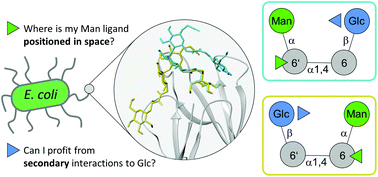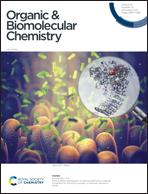Synthesis of regioisomeric maltose-based Man/Glc glycoclusters to control glycoligand presentation in 3D space†‡
Abstract
The investigation of carbohydrate recognition in a natural environment suffers from the complexity of overlapping functional effects such as multivalency and heteromultivalency effects. Another key factor in carbohydrate recognition is the presentation mode of glycoligands in three-dimensional (3D) space. In order to trace out the effect of 3D ligand presentation, we utilized an oligosaccharide model to precisely control the spatial relation between a mannose ligand (Man) and a glucose moiety (Glc). A disaccharide (maltose) served as a scaffold to alternately conjugate Man and Glc at position 6 and 6′ of a synthetic maltoside, resulting in a pair of regioisomeric heterobivalent glycoclusters. The biological effect of this specific structural tuning was tested in a native system employing mannose-specific adhesion of live E. coli cells. Indeed, the variable 3D presentation of the Man ligand resulted in a 2-fold difference between the regioisomeric heterobivalent glycoclusters as inhibitors of bacterial adhesion. This can be considered a remarkable effect, which could be interpreted by computer-aided modelling of the complexes between the bacterial lectin and the synthetic regioisomeric glycoligands.

- This article is part of the themed collection: Chemical Biology in OBC


 Please wait while we load your content...
Please wait while we load your content...